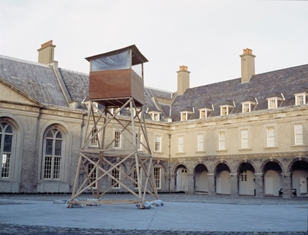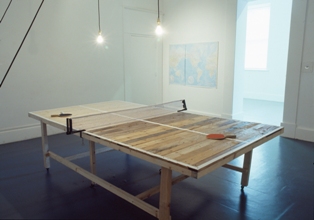Process Room, 16.01.08- 03.02.08
Ping-Pong Diplomacy, My World Is Over and Splendid Isolation are new works initiated by artist Mark Clare while on the Artists’ Residency Programme at the Irish Museum of Modern Art.
This work is a representation of world gone by – the decline of failed ideologies and territorial revisions leading to the construction of new states in a world in constant flux due to technology, geo-politics and economics. The materials and processes used have an obvious use or value and incorporate a symbolism relating to historical representation in both social and artistic associations.
Ping-Pong Diplomacy and My World Is Over
“One of the first public hints of improved U.S. – China relations came on April 6th 1971, when the American Ping-Pong team received a surprise invitation from their Chinese colleagues for an all-expense paid visit to the Peoples Republic. Probably never before in history has a sport been used so effectively as a tool of international diplomacy, with its premium on delicate skill and its onomatopoeic name implies interplay of both initiative and response. Ping Pong was an apt metaphor for the relations between Washington and Peking.” Time Magazine
A visit to any Communist or ‘former’ Communist bloc country will be met with the observation of table tennis tables placed outdoors in public arenas for recreational use by the local community. These tables are the remnants of a failed ideology that at one time offered a new hope and later symbolised ‘evil’ in a power struggle for political supremacy as perceived through Western Culture.
Ping-Pong Diplomacy consists of a table tennis table constructed by the artist using a combination of re-cycled wood (pallets) and commercial flooring boards. The table has been built to official dimensions, but it will take more than skill to fully utilise its possibilities. While one half of the table has the appearance of a superior finish compared to the more chaotic aspect of the re-cycled half they both have their qualities and their foibles that need to be negotiated and understood to utilise the table and the individuals’ skills to affect a positive outcome.
The second work on show in the process room My World Is Over emphasises how Europeans are used to a map with Europe at its centre, whose geographical “middle” is Germany. The Atlantic, the great “Central Ocean”, separates the Old and New Worlds. For Europeans, there seems to be nothing particularly unusual or significant about this perspective, which has been the standard for centuries and has defined a certain gaze and attitude. One gets a completely different perspective, however, if we rotate the globe ninety degrees so that America occupies the maps centre. Suddenly, a new vista opens up on the “floating islands” of the world. Europe is no longer the centre of focus but merely a part of the periphery. My World Is Over consists of a household map that has been cut up and put back together to emphasise the dominant role that the U.S plays in today’s Global politics. At the same time all landmass features have been erased, there are no border definitions in a world where territorial revisions lead to the construction of new states.
Splendid Isolation
“Morals reformed – health preserved – industry invigorated – instruction diffused – public burdens lightened – all by a simple idea in Architecture!” Jeremy Bentham
The 18th century utopian philosopher, Jeremy Bentham, had a concept of design called a Panopticon, which would allow an observer to view all prisoners without the prisoners being able to tell if they are being observed or not, thus conveying a “sentiment of an invisible omniscience”. The architecture "incorporates a tower central to a circular building that is divided into cells. The occupants of the cells are backlit and subject to scrutiny both collectively and individually by an observer in the tower who remains unseen". In his own words, Bentham described the Panopticon as "a new mode of obtaining power of mind over mind, in a quantity hitherto without example". In the 1930’s, in an effort to define the borders of a modern Israel the Jewish settlers devised The Homa Umigdal or Wall and Tower settlements. It was the first expression of the Jewish native architectural tradition known as Adrikhalut. This architectural phenomenon was initiated and conducted almost ‘without architects’, in the service of political objectives. The system was based on a hasty construction of a wall made of prefabricated wooden moulds filled with gravel and surrounded by a barbed wire fence. All in all, the enclosed space formed a 35×35 metre yard. In the centre a 12-meter high prefabricated wooden tower commanded the view of the surrounding area.
Splendid Isolation consists of a tower replicating the ones used by the Jewish Settlers and is approximately 8 meters tall. The Tower works on many different levels. While at the same time it functions as an architectural structure it also examines the role of monumental sculpture as a form of celebration utilized throughout cities. It is rooted in the history of Imperialism and Colonisation throughout the world. It relates not only to the process in which cities are initiated but also to the modern phenomenon of 24-hour surveillance within modern society and our acceptance for such a need. Placed centrally within the inner courtyard of the Irish Museum of Modern Art, the tower, its redundant architecture and its sculptural presence, draws attention to the architecture and the history of the buildings past and its present function.
Mark Clare was on the Artists’ Residency Programme from September 2007 until February 2008. Clare has had several solo shows including, One Mans Terror Is Another Mans Freedom, RHA Gallery, Dublin, 2007; Another Day in My Kingdom, Gallery of Photography, Dublin, 2007; Nothing is Out Of Place, Oberpfälzer, Schwandorf, Germany, 2006 and Know Thyself, Temple Bar Gallery and Studios, Dublin, 2005. Following IMMA Splendid Isolation will be showing in Limerick at EV+A, March 2008.
For a printable version of this information please download the following document Mark Clare:Process room word doc.
Mark Clare:Process room word doc.
Click here to return to Previous Participants
Click  here to browse ARP Projects
here to browse ARP Projects

